List of Authors
>>About this blog
Recent blog post
|
[Sam]
January 26, 2018 16:00
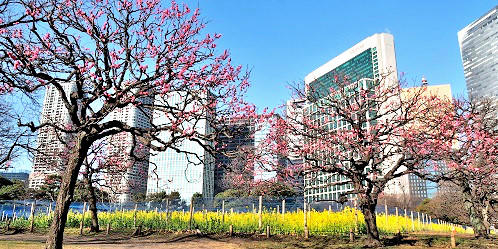 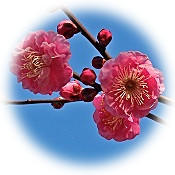 On January 19, the Tokyo Regional Meteorological Observatory reported "Plum Flowering", one of the Japan Meteorological Agency's biological seasonal observation information. (Kitanomaru-koen Park) On January 19, the Tokyo Regional Meteorological Observatory reported "Plum Flowering", one of the Japan Meteorological Agency's biological seasonal observation information. (Kitanomaru-koen Park)
7 days earlier than normal and 9 days later than last year.
The flowering of Bairin in the Hamarikyu Onshi Garden has not yet been heard, but on the side of the flower garden, the calm, dark pink early blooming "Yae Kanku" is at its best.
While many flower buds are still hard, it is a kind of "Noume" that begins to bloom in the cold season, and the middle ring of double-flowered.
The flower garden canola flower is covered with a net and is still curing, but its height has grown considerably, the yellow flower color has become conspicuous, and the landscape of the park has begun to be colored in spring-like colors.
The severe cold continues every day, but it makes me realize that spring is steadily approaching.
[Sam]
January 23, 2018 12:00
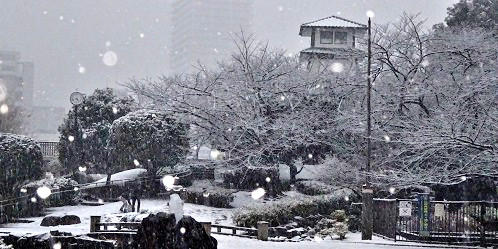 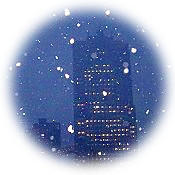 On January 22, a cyclone with a front developed near the west and south coast of eastern Japan and proceeded almost east, and snowfall in a wide area. On January 22, a cyclone with a front developed near the west and south coast of eastern Japan and proceeded almost east, and snowfall in a wide area.
In central Tokyo, "Sleet", which is a mixture of snow in the morning, followed by snow falling, heavy snow in the afternoon, and heavy snow warning was issued for the first time in four years since February 2014.
The snow this time is wet and heavy snow that contains a lot of moisture due to the "South Bank Low Pressure".
At 10:00 pm, the snowfall in the city center recorded 23 cm, approaching the level of 27 cm observed on February 8, 2014.
Tsukuda Park is also a silver world.
It is wrapped in a sense of silence that is different from usual, and the St. Luke's Tower seen from Tsukuda Park is hazy and fantastically emerges.
[Sam]
January 19, 2018 09:00
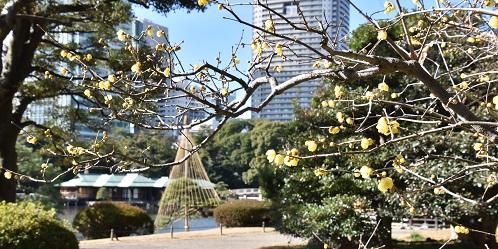 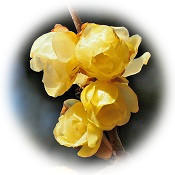 In this season with little greenery and severe cold weather, near the tide pond in the Hamarikyu Onshi Garden, near the pine Ochiyaya, a beautiful, glossy yellow flower similar to beeswax, `` Soshin Waki Ume '' . In this season with little greenery and severe cold weather, near the tide pond in the Hamarikyu Onshi Garden, near the pine Ochiyaya, a beautiful, glossy yellow flower similar to beeswax, `` Soshin Waki Ume '' .
Although the name is "ume", it is a deciduous shrub of the Japanese allspice genus native to China, and is originally a horticultural variety with multicolor flower-colored "waku plum".
The unique texture of the petals that can be seen through warm days. In addition, it is faintly sweet, fruity and refreshing aroma derived from essential oil components such as linalol, Borneool and cineool.
Compared to the early blooming plums that have begun to bloom, the fragrance is stronger and clear, and its fragrant aroma feels at ease.
It seems to be popular not only as a garden tree, but also for ikebana and tea flowers, as well as for bonsai and potted plants.
In addition, "Waku plum" is also blooming in Hanakien.
[Sam]
January 15, 2018 09:00
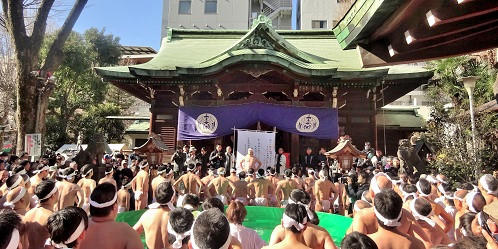 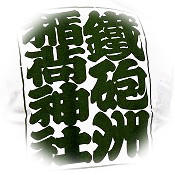 From 11:00 on January 14th, the annual New Year's "63rd Cold Bathing Tournament" was held at Tepposu Inari Shrine. From 11:00 on January 14th, the annual New Year's "63rd Cold Bathing Tournament" was held at Tepposu Inari Shrine.
Every year at Tepposu Inari Shrine on the second Sunday of New Year's Day, during the cold water bath is a Shinto ritual that prays for sound health by performing a purification ceremony in front of the shrine in New Year's Day.
This is a traditional festival celebrating its 63rd anniversary this year, which was revived by the predecessor Miyaji in 1955 as the "Cold Water Bathing Tournament".
After the exorcism of Miyaji Nakagawa, under the guidance of the Tokyo Shrine Agency's training event Michihiko (= leader) Shino Itabashi Hikawa Shrine Miyaji, first go out on a public road and run around the shrine. Next, while the Tepposhu Hayashi dedicated to the Kagura Hall is flowing, the preparatory movement of rowing a boat with a turret, a bird boat (boat), etc., enters the cooled water tank with a large icicles, soaks in cold water to the chest, and shouts, "Araido Ogami ..."
After the end, we will conduct a campaign to organize bird boats again and finish the cold purification ceremony.
In the precincts, warm amazake was served to worshipers.
[Sam]
January 13, 2018 09:00
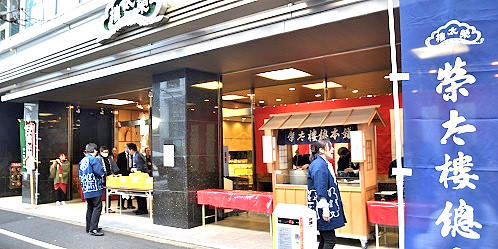 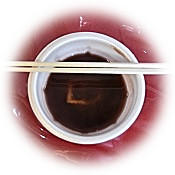 From 14:00 on January 11th, at the Nihonbashi Eitaro Sohonpo, the annual New Year's annual "Kamikaiki" was held, and the first 500 people were served with rice cake soup powder. From 14:00 on January 11th, at the Nihonbashi Eitaro Sohonpo, the annual New Year's annual "Kamikaiki" was held, and the first 500 people were served with rice cake soup powder.
The music of Edo Dai-Kagura, a popular performing art centering on lion dance and acrobatics, is said to have a history of 400 years at Intangible Folk Cultural Property designated by Tokyo.
Kagamibiraki is an annual event in which kagami mochi, which had been offered to household miniature shrine and tokonoma as New Year's decorations, is lowered, thanks to Shinto and Buddha, wishes for sound health, and eaten with zoni or soup powder.
In the past, kagami mochi was supposed to break it with a mallet or open it by hand, and it is said that the use of red beans is reminiscent of ancient red rice.
On the cold body, hot soup powder heals the mind and body.
[Sam]
January 9, 2018 16:00
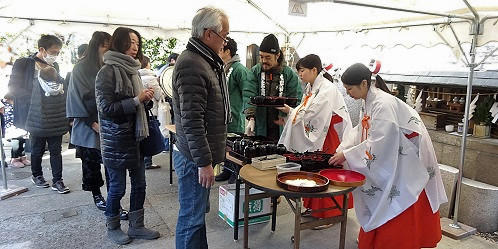 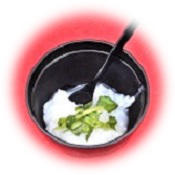 January 7th is a festival of people's day. January 7th is a festival of people's day.
At Tsukiji Nami Inari Shrine, the annual New Year's annual “Nanakusa Shinto ritual” festival was held from 11:00, followed by “Nanakusa porridge” on the grounds.
The 7th of New Year's Day marks the milestone of the New Year's event, and on the morning of this day, we eat seven herbs porridge containing seven herbs (seri, Nazuna, today, Hakobera, Hotokenoza, Suzuna, Suzushiro) that grew fromsound health.
Speaking of the 7th, it is the last day of Matsunouchi, and it is a reasonable practice because there is one aspect of nutritional supplement in winter, when the stomach and intestines are tired of the New Year's treats and tends to be short of green vegetables.
Seven herbs porridge prepared by Chosei-an using rice from the sacred rice field and herbs dedicated to Fujimoto Shoten at Tsukiji Outer Market.
The lightly finished porridge is a hospitality that conveys warmth and tenderness under the cold sky after a slightly darker osechi dish continues.
|
Links
|

 On January 19, the Tokyo Regional Meteorological Observatory reported "Plum Flowering", one of the Japan Meteorological Agency's biological seasonal observation information. (Kitanomaru-koen Park)
On January 19, the Tokyo Regional Meteorological Observatory reported "Plum Flowering", one of the Japan Meteorological Agency's biological seasonal observation information. (Kitanomaru-koen Park)
 On January 22, a cyclone with a front developed near the west and south coast of eastern Japan and proceeded almost east, and snowfall in a wide area.
On January 22, a cyclone with a front developed near the west and south coast of eastern Japan and proceeded almost east, and snowfall in a wide area.
 In this season with little greenery and severe cold weather, near the tide pond in the Hamarikyu Onshi Garden, near the pine Ochiyaya, a beautiful, glossy yellow flower similar to beeswax, `` Soshin Waki Ume '' .
In this season with little greenery and severe cold weather, near the tide pond in the Hamarikyu Onshi Garden, near the pine Ochiyaya, a beautiful, glossy yellow flower similar to beeswax, `` Soshin Waki Ume '' .
 From 11:00 on January 14th, the annual New Year's "63rd Cold Bathing Tournament" was held at Tepposu Inari Shrine.
From 11:00 on January 14th, the annual New Year's "63rd Cold Bathing Tournament" was held at Tepposu Inari Shrine.
 From 14:00 on January 11th, at the Nihonbashi Eitaro Sohonpo, the annual New Year's annual "Kamikaiki" was held, and the first 500 people were served with rice cake soup powder.
From 14:00 on January 11th, at the Nihonbashi Eitaro Sohonpo, the annual New Year's annual "Kamikaiki" was held, and the first 500 people were served with rice cake soup powder.
 January 7th is a festival of people's day.
January 7th is a festival of people's day.
